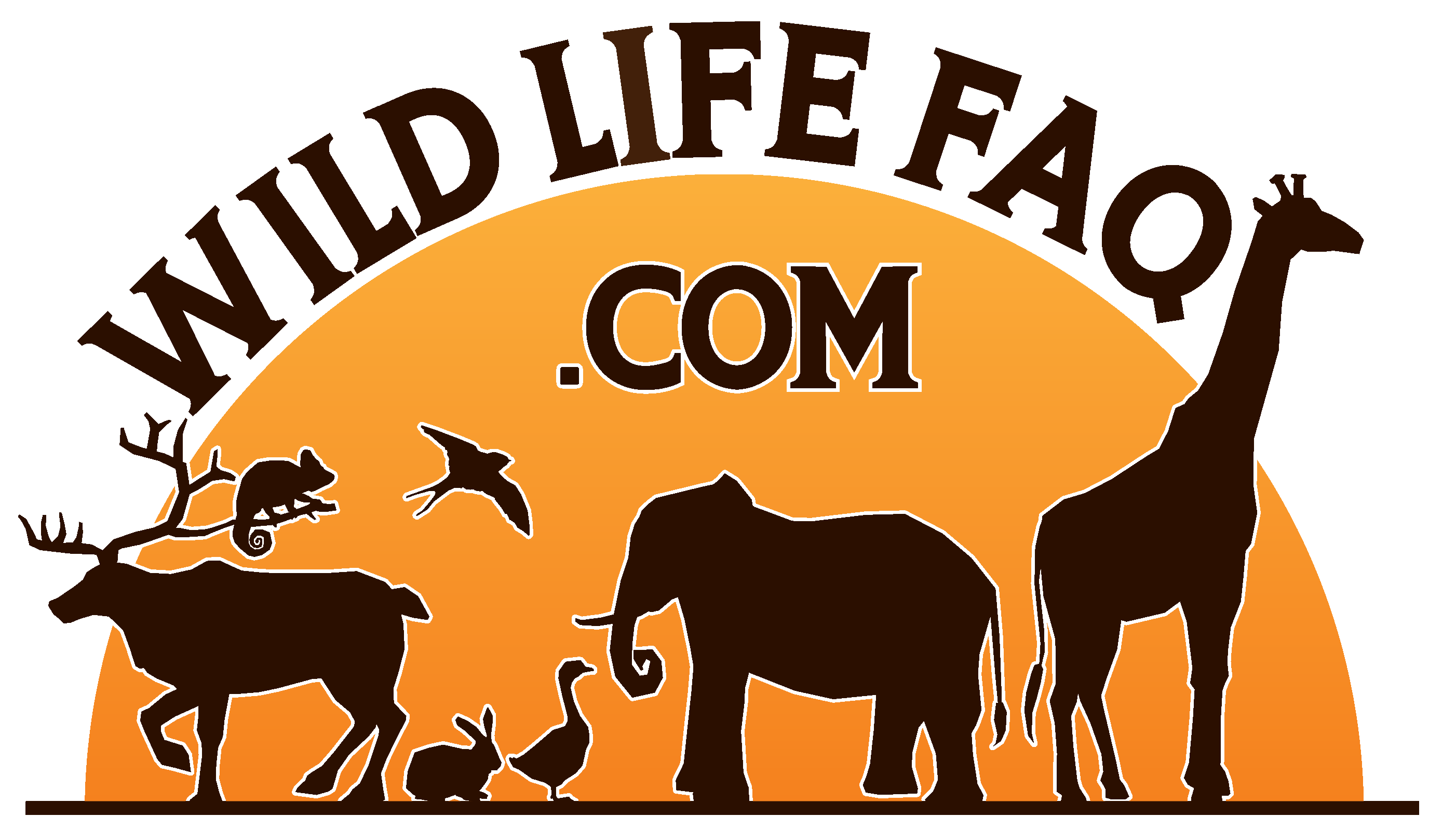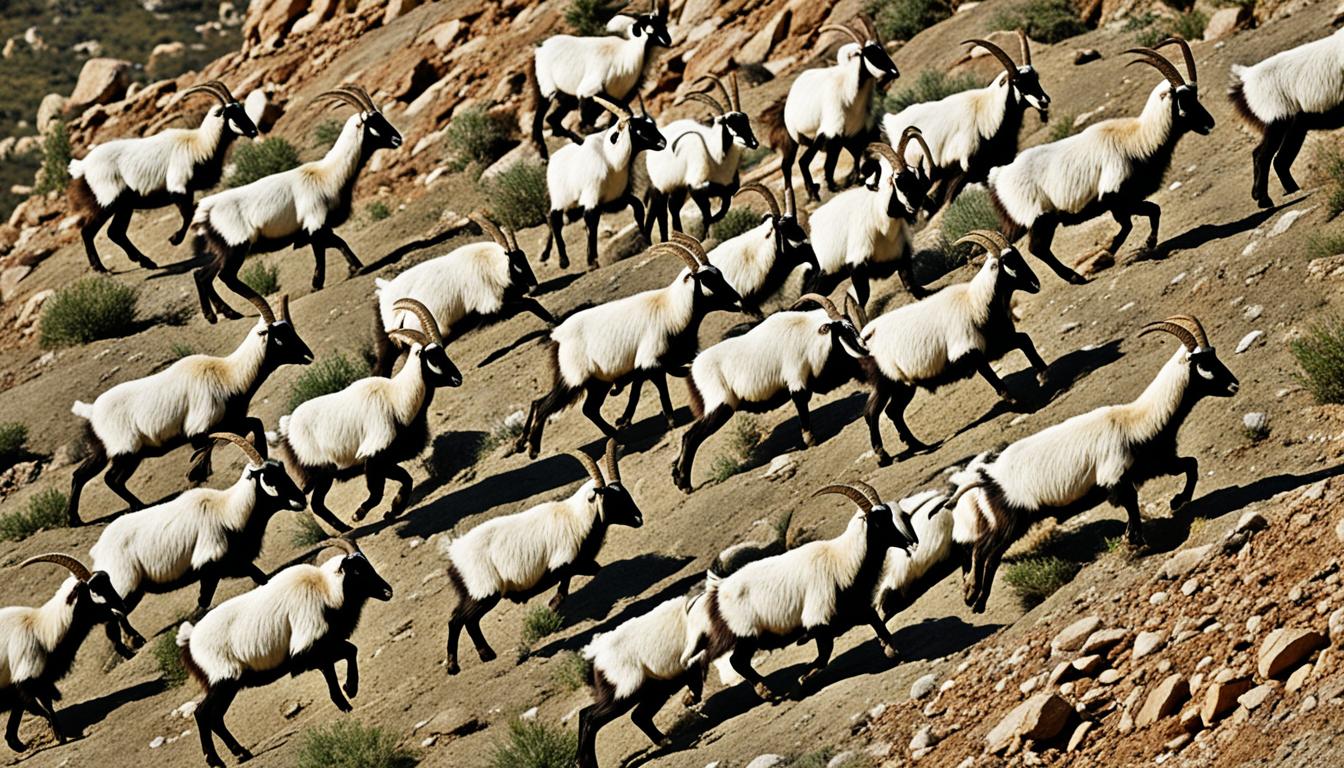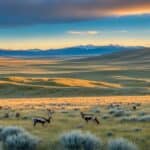Mountain goats, known by their scientific name Oreamnos americanus, are the only wild goats native to the USA. They are often called Rocky Mountain goats. They live in the severe mountainous areas of western North America.
These goats are special because they succeed in the very high places of the Rocky Mountains and the Cascade Range. They are sometimes mistaken for true goats. But, their ability to live in such rough terrain sets them apart from other native American animals.
Introduction to Native Wildlife in the United States
The wildlife in the United States is very rich and diverse. It includes species living in various natural habitats. One example is the mountain goat, an *indigenous goat species*. These agile creatures live in alpine and subalpine regions. They are the country’s only wild goats.
The mountain goat is vital to its environment. It helps keep nature’s balance in North America’s high places. These goats are an essential part of the continent’s diverse mountain habitat.
These *American wild goats* are well-suited to cold, tough terrains. They have skills and features that set them apart from other U.S. wildlife. Their talent for climbing rough terrains shows how well they fit their environments.
Learning about the *indigenous goat species* helps us see the importance of U.S. wildlife. It shows why we must work to protect these animals and the lands they live in. By preserving them, we maintain the rich biodiversity of the United States.
Mountain Goats: The Only Native Wild Goat in the USA
Mountain goats have a special place as the sole wild goat species native to the USA. They show us how animals can adapt to very high places. We will look into their scientific name, what they look like, and where they live.
Scientific Classification of Mountain Goats
Mountain goats fall under the animalia kingdom in the mammalia class. They are in the order Artiodactyla, which includes cows, deer, and pigs. Specifically, they’re in the bovidae family and the subfamily Caprinae. Their scientific name is Oreamnos americanus. This set of names tells us these goats are really something special.
General Characteristics of Mountain Goats
Mountain goats are known for their climbing skills. They have strong bodies, short tails, and beards. Their protectively colored long horns and woolly coats help them blend into their snowy, rocky homes. These facts make mountain goats stand out from other high-altitude animals.
Habitat and Range of Mountain Goats
Mountain goats live in mountain areas across North America. This includes the Rocky Mountains and the Cascade Range. They like living in areas with some trees all the way up to the snowy, treeless tops. From Washington all the way through Alaska, they’re showing they can handle a range of tough environments.
Distribution of Mountain Goats Across North America
Mountain goats have an interesting range across North America. They can be found in the Rockies to the Cascades. These amazing animals have adapted to life in various mountain habitats.
Mountain Ranges Inhabited by Mountain Goats
Mountain goats cover a large area from British Columbia to Alaska. The Rocky Mountains and the Cascades have big populations. They can live in very tough, cold places with ease.
Historical and Modern Range Expansion
Goats’ habitats grew over time naturally. People helped them move to new areas too. Now, places like Idaho and Colorado are also their homes.
Are there any native wild goats in the USA?
Are there any native wild goats in the USA? Yes, but only one type. The mountain goat, known as Oreamnos americanus, is the answer. It’s unique to the country. These goats live in the hard-to-travel western North America. This area includes the Rocky Mountains and the Cascade Range.
There aren’t other native wild goats in the USA. This makes the mountain goat very special. They’re great at living in high places. These goats are important for their ecosystems. So, the answer to are there any native wild goats in the USA? is yes, the mountain goat is unique here.
Similar Animals: Distinguishing Mountain Goats from True Goats
Mistaking mountain goats for true goats is common, but these two are quite different. Mountain goats, or Oreamnos americanus, are not true goats but more like ‘goat-antelopes.’ They have specific features that help them live in tough mountain areas.
Differences Between Mountain Goats and True Goats
Mountain goats and true goats are not the same. Mountain goats have compact bodies and hooves for climbing. This sets them apart from true goats, which humans have adapted for a variety of uses.
| Characteristic | Mountain Goats | True Goats |
|---|---|---|
| Taxonomy | Goat-antelope | True Goat |
| Physical Build | Robust, shorter bodies | Variable, often leaner |
| Habitat | Mountainous terrain | Various, often pastoral environments |
| Hooves | Specialized for climbing | General-purpose hooves |
Adaptations for Mountainous Terrain
Mountain goats are well-adapted for life in the mountains. Their hooves and dewclaws help them climb. They also have strong muscles and thick coats to stay warm and thrive despite harsh weather.
These adaptations are critical, highlighting the stark differences between mountain goats and true goats. Mountain goats capture the interest of researchers and those who love nature.
Ecological Importance of Mountain Goats
Mountain goats are key in keeping the alpine ecosystem healthy and balanced. They provide many ecological benefits through their activities in their environment.

Role in the Alpine Ecosystem
Mountain goats have several vital ecological roles. As herbivores, they eat various alpine plants. This eating affects which plants grow, helping new ones to thrive and fostering biodiversity. They also become food for predators like black bears, pumas, and wolves, enriching the wildlife food web.
Interactions with Other Species
These goats interact with many animals in their home, creating a complex natural network. They not only influence plants but also the lives of other eating and predator animals. For example, their competition with bighorn sheep impacts how both species survive. Besides, their droppings improve the soil, aiding more plant growth and supporting a whole variety of animals. This interconnected role means saving mountain goats is vital for the whole alpine area.
Conservation Status and Threats to Mountain Goats
Mountain goats are doing well and labeled as “Least Concern” by the IUCN. This means their population is steady. But, they face threats that could hurt them in the long run. Human activities, like building and recreation, are taking away their living areas. This loss is big trouble for them. Also, climate change is changing where they live. This affects their food and home.
Mountain goats find it tough living with bighorn sheep. They can catch more diseases this way and have to fight over food. If a disease spreads among them, it’s very bad news. This is especially true in places where not many goats live together.
It’s really important to find ways to protect mountain goats and where they live. Protecting their homes, opening safe paths for them, and keeping people from bothering them are key steps. By taking care of the goats, we also keep their homes healthy. This is good for all the different plants and animals that live there.
| Threat | Impact | Conservation Efforts |
|---|---|---|
| Habitat Loss | Decreased living spaces and food scarcity | Preservation of alpine habitats |
| Climate Change | Altered habitats and food sources | Climate resilience programs |
| Competition with Bighorn Sheep | Resource scarcity and increased disease transmission | Wildlife corridors and monitoring |
| Disease | Population declines | Health monitoring and vaccination programs |
Reintroduction and Management of Mountain Goats in the USA
Bringing back mountain goats in the United States mixes success with hard work. This is important for bringing back native animals, keeping nature balanced, and saving different species.
Historical Reintroduction Efforts in Colorado and Other States
In the USA, the effort to reintroduce mountain goats began in Colorado. It started in 1947 by moving these animals from Montana. This helped the local goat population grow again after being wiped out. With similar efforts in Idaho, Wyoming, and South Dakota, these programs work to put native animals back where they belong.
The main aim is to return animals to their natural homes. This work is part of a bigger plan to look after the country’s wildlife in a way that helps ecosystems stay healthy.
Challenges and Controversies in Management
Overcoming challenges is key, even with the success of bringing mountain goats back. A big problem is the fight for space between mountain goats and bighorn sheep. This competition can harm the place they live and upset the balance of nature.
Another tough issue is about mountain goat hunting. Hunting is an old practice but we need to make sure it doesn’t harm the goat’s numbers. There’s a balance to keep between tradition and looking after our wildlife.
Deciding on how to manage mountain goats can be very debated. For instance, at places like Summit Lake and the Mount Peale Research Area, there are arguments. People discuss how we can keep nature safe, allow some hunting, and make sure people visiting don’t harm the area.
The Future of Mountain Goats in Their Native Habitats
Mountain goat populations are under pressure from changing environments. Their survival depends on using smart and caring methods. These methods focus on keeping their homes in America safe. By doing this, we help keep these alpine animals around for a long time.
It’s crucial to protect where mountain goats live. Their environments are unique and vital for a healthy earth. We must deal with the effects of climate change. This is because changes in weather can harm where these goats live.
It’s also very important not to mix these goats with species from elsewhere. Mixing them could cause fights over food and mess up the current way things work. We need to act with care and use methods that protect their homes. This will help keep mountain goats and their diverse mountain habitats safe for those who come after us.
FAQ
Are there any native wild goats in the USA?
Yes. The mountain goat, also known as the Rocky Mountain goat, is native to the USA. They live in the Rocky Mountains and the Cascade Range. These goats prefer high-altitude places.
What is the scientific classification of mountain goats?
Mountain goats are part of the animalia kingdom and the mammalia class. They are in the order Artiodactyla and the subfamily Caprinae. Their scientific name is Oreamnos americanus.
What are the general characteristics of mountain goats?
They have strong bodies, beards, and short tails. Mountain goats sport long, black horns. A woolly, white coat keeps them warm in cold, high places.
Where is the habitat and range of mountain goats?
These goats live in the western part of North America. Their home stretches from Washington to Alaska. They are common in the Rocky Mountains and the Cascade Range.
Which mountain ranges do mountain goats inhabit?
Mountain goats call places like the Rocky Mountains and the Cascade Range home. They are also found in British Columbia, Alberta, and Alaska.
How has the range of mountain goats expanded historically and in modern times?
Mountain goats have spread to new areas through natural movement and also with human help. Now, they can be found in places they haven’t been before.
What are the differences between mountain goats and true goats?
Mountain goats are not true goats, though they seem alike. They have features like cloven hooves and woolly coats. These are not seen in farm goats.
What adaptations help mountain goats in mountainous terrain?
Mountain goats have special hooves for climbing. They also have powerful muscles for climbing steep areas. Their double coat protects them from harsh weather.
What is the ecological importance of mountain goats?
These goats are key in their ecosystems. They feed on plants and help keep the habitat diverse. Their actions help shape the environment they live in.
How do mountain goats interact with other species?
Mountain goats share their space with bears, pumas, wolves, and sheep. These other animals also play a role in mountain goat habitat.
What is the conservation status of mountain goats?
The IUCN sees mountain goats as safe for now. But, they face threats like losing their home, sickness, and climate change. It’s important to protect them.
What were the historical reintroduction efforts for mountain goats in Colorado and other states?
In 1947, Colorado got its first mountain goats from Montana. Since then, these animals have also been introduced to other states. The goal is to return them to where they belong.
What challenges and controversies exist in the management of mountain goats?
Managing mountain goats brings challenges. These include dealing with where they live, who they share their space with, and how people like to hunt them. Not everyone agrees on the best way to protect them.
What does the future look like for mountain goats in their native habitats?
The future of mountain goats needs careful planning. This includes protecting their home and looking at how climate change affects them. It’s crucial to keep their ecosystems in balance for them to survive.







